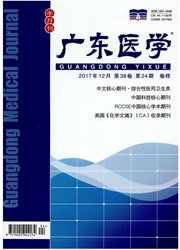

 中文摘要:
中文摘要:
目的探讨短程放疗联合替莫唑胺(TMZ)方案在术后KPS评分较差的老年胶质母细胞瘤(GBM)患者治疗中的生存获益情况。方法回顾分析行完整切除但术后KPS评分不佳的新诊断老年GBM患者71例,对不同MGMT状态下各辅助治疗方案进行生存分析和比较。结果 71例患者年龄65~85岁,平均(71.10±5.19)岁,其中男50例,年龄(71.36±5.35)岁,女21例,年龄(70.48±4.90)岁;其中62例在随访截止日期前死亡,总体平均生存期(OS)(11.92±0.51)个月,2年生存率0;接受短程同步放化疗联合TMZ辅助治疗组平均生存期显著提高(P=0.002),与单纯短程放疗组相比差异性最大(P=0.001),而单纯短程放疗与单纯TMZ辅助治疗组之间OS差异无统计学意义(P〉0.05);术后免疫组化MGMT阴性表达组患者更能从短程同步放化疗联合TMZ辅助化疗中获得生存获益(P=0.004)。结论对于≥65岁接受肿瘤切除后功能状态不佳的老年GBM患者,短程同步放化疗联合TMZ辅助治疗可能是一种能获得更多生存获益的术后辅助治疗方案,在MGMT启动子甲基化患者中,这种获益优势更加明显。
 英文摘要:
英文摘要:
Objective To investigate if a short- course concurrent chemoradiotherapy that yields a better mean survival in elderly patients with newly diagnosed glioblastoma multiforme( GBM) and poor post- operation performance. Methods This study included 71 newly diagnosed primary GBM patients aged 65 years or older with poor post- operation KPS. Kaplan- Meier method stratified by MGMT status was used to compared the survival in different groups. Results The mean age was( 71.10 ± 5.19) years old,among whom the mean age of 50 males was( 71.36 ± 5.35) years,and of 21 females was( 70.48 ± 4.90) years. Sixty- two cases died during follow- up,and the two- year survival rate was 0%. The mean overall survival of short- course concurrent chemoradiotherapy increased significantly( P = 0.002)compared to short- course radiotherapy- alone and TMZ- alone( P = 0.001). It got more survival benefit for patients with negative MGMT( P = 0.004). But there was no significant difference between short- course radiotherapy- alone and TMZ- alone( P〉0.05). Conclusion Short- course concurrent chemotherapy may be a optimization adjuvant therapy plan to elderly patients with newly diagnosed GBM and poor post- operation performance,and this advantage is more obvious in patients with MGMT promotor methylation.
 同期刊论文项目
同期刊论文项目
 同项目期刊论文
同项目期刊论文
 期刊信息
期刊信息
